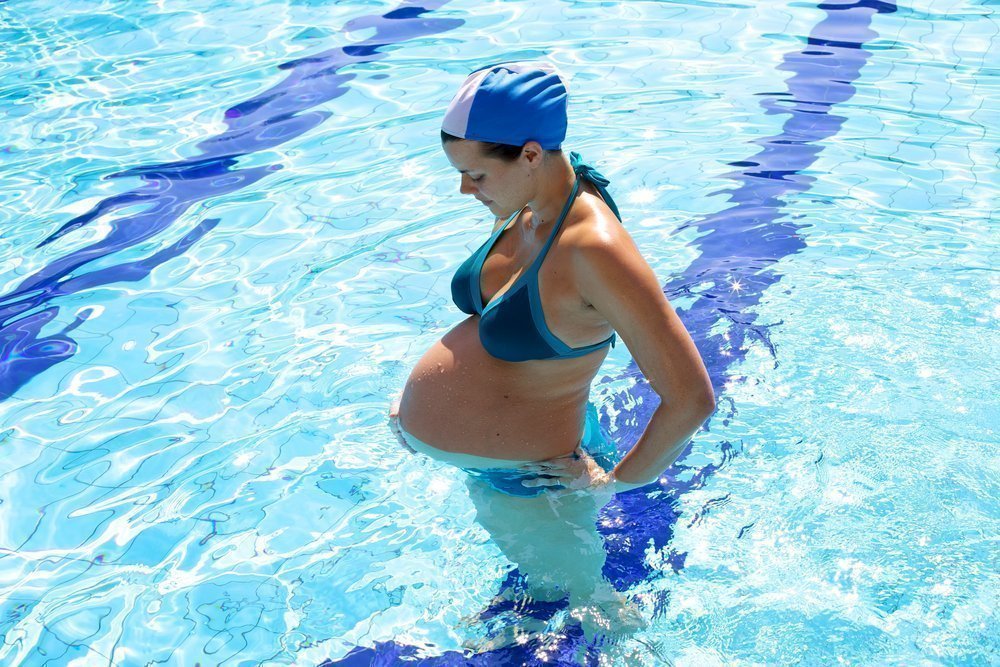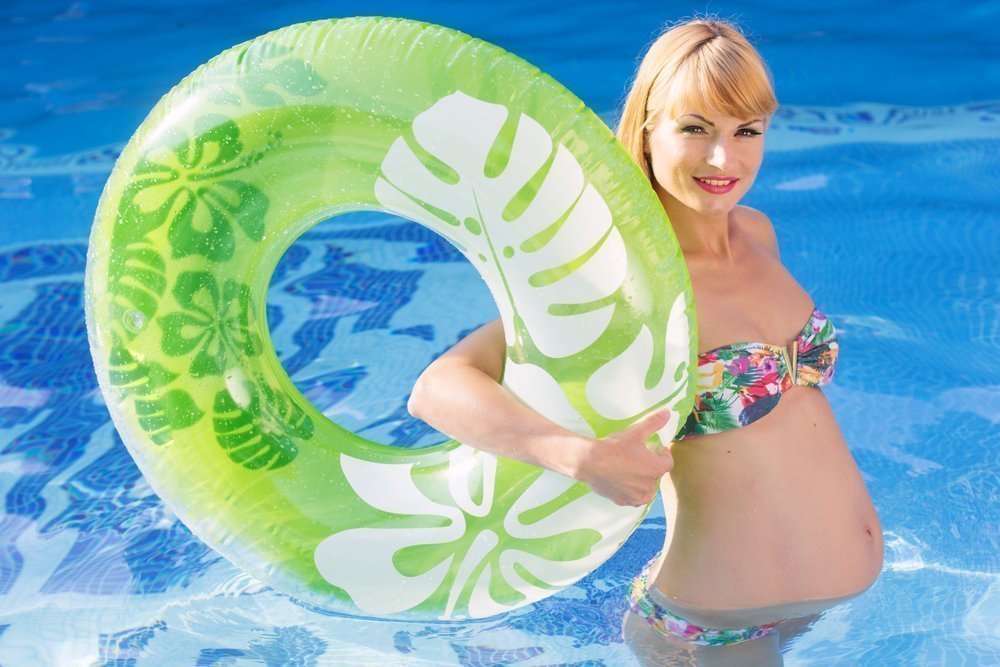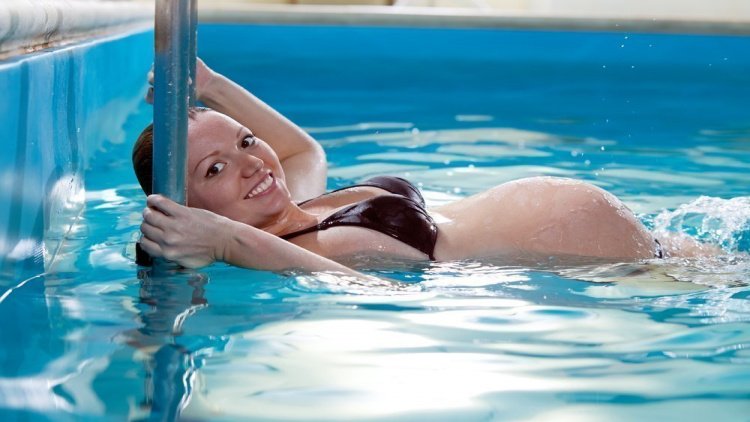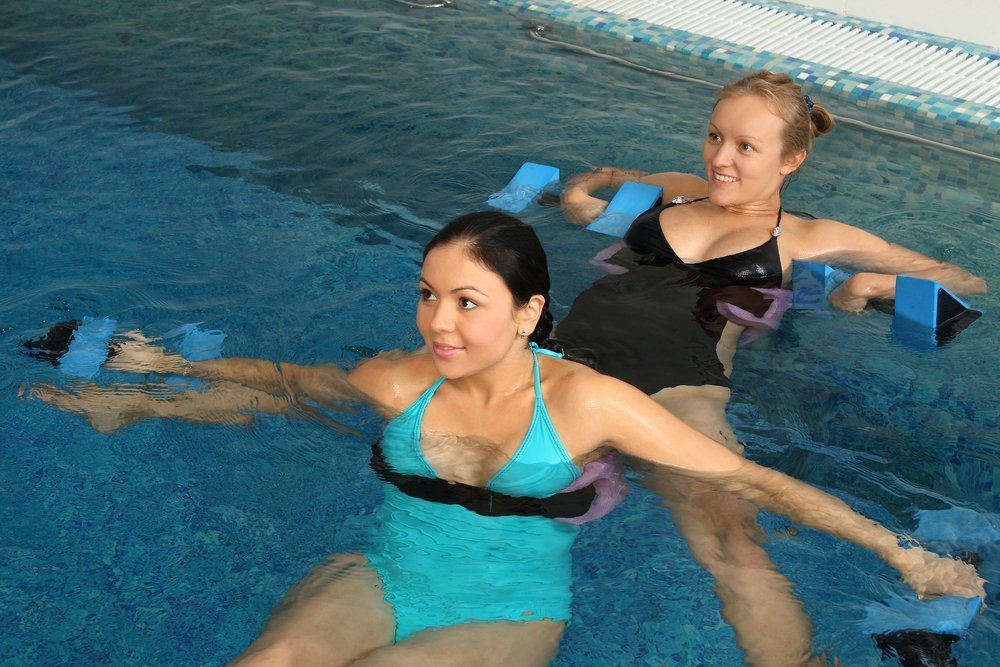Water aerobics classes help women at any stage of pregnancy to maintain the overall tone of the body. Gentle exercises performed in water allow you to engage all the major muscle groups, activate blood circulation and metabolism, have a beneficial effect on pregnancy. This helps a woman’s body to resist infectious diseases, easier tolerate hormonal changes and prepare for the birth of a child.
Exercise complex for pregnant women consists of the same elements as fat-burning workouts, but they are performed at a lower intensity and with a reduced level of load. There are a number of contraindications for strengthening fitness exercises in the pool, related to the problematic course of pregnancy and the threat to the fetus. Therefore, you should consult your doctor before starting to exercise in water.
Benefits and drawbacks of aqua aerobics at different stages of pregnancy

The term of pregnancy does not play a role for the beginning of aqua aerobics, if there are no medical contraindications to training. But it is necessary to take into account that as the fetus develops and the abdomen increases, you will have to make adjustments to the training program and emphasize on certain exercises.
Early pregnancy (first trimester)
During this period, significant changes and realignments in the major systems of the body begin. Hormonal background and metabolic processes change, internal organs of the fetus are formed. These changes are accompanied by poor health, general weakness.
If a woman has not participated in sports before pregnancy, sports should be started with minimal load, gradually increasing the intensity of exercise. Sudden movements and heavy exercise in the first trimester can lead to the threat of miscarriage.
Late term pregnancy (second and third trimesters)

Gymnastic exercises in water are very useful in the second trimester of pregnancy. The threat of miscarriage is significantly reduced by this term, and the size of the abdomen does not yet limit a woman’s movements. This is the period when it is recommended to do regular exercises and strengthen the body before the birth.
In the last trimester, exercise should be drastically limited. Preference should be given to static and smooth movements and breathing exercises. Fast and dynamic elements are recommended to be excluded from the training program. During this period, the body hardly tolerates high pressure, rapid acceleration of blood circulation and heart rate.
Useful qualities of aqua aerobics:
- A woman does breathing exercises and learns how to breathe properly.
- Working out in water allows you to gently strengthen the abdominal and pelvic muscles. It is these muscles will actively participate in the process of childbirth.
- Doing exercise in the water helps actively burn calories and prevents a lot of weight gain during pregnancy.
- Exercising in the pool helps you relax and cope with stress and nervous tension.
- Aqua aerobics improves blood circulation in the legs and prevents the development of varicose veins.
- Working out in the pool does not strain or traumatize your spine.
- The work of internal organs and body systems is improved.
- After class you will not feel any pain in your muscles and joints.
- Water regulates the temperature balance during your workout, and will keep you from overheating.
Disadvantages of working out in a pool:
- Chlorine compounds in the water negatively affect your skin and hair.
- Pool exercise is contraindicated if you have acute allergies or asthma.
- You may get a yeast infection after exercising in a public pool.
Recommendations and contraindications for exercise in the water
Aqua aerobics has a general strengthening effect on the body of the future mother. In addition, physical exercises in the pool are indicated for a number of pathologies occurring during pregnancy. These are:
- Severe swelling of the face and extremities in pregnant women. Excess fluid in the body can provoke oxygen starvation of the fetus. In this case, with the doctor’s permission, physical activity in the form of exercises in water will be very useful.
- Overweight in the expectant mother. During an hour in the pool, the body consumes more than 700 kcal.
- Low muscle tone. Exercise in the water forces all muscle groups to work.
In addition, the gentle massaging action of water helps with digestive problems and varicose veins. Also, doing exercises in the pool will help the baby get into the right position before delivery.
Contraindications to classes:
- If there is a threat of miscarriage.
- Acute manifestations of gestosis (protein in the urine).
- Severe manifestations of toxicosis.
- Individual predisposition to preterm birth.
- Acute candidiasis and other fungal diseases.
Recommendations for exercising and exercise

As we mentioned before, any gestational age is suitable for starting a pool workout. The duration of the workout should be 40-45 minutes. An aqua aerobics session consists of three parts:
- Warm-up (7-10 min).
- Basic (25-30 min).
- Concluding (5-10 min).
Training is done in small groups of 10-15 people. If you do not know how to swim, you can use aids.
Warm-up
Consists of simple and smooth movements to warm up the muscles and activate blood circulation (smooth strokes, jumps and walking). The warm-up is carried out near the pool.
Main part
- Stretching exercises (done in the shallow part of the pool)
- Lunges to the sides. Squat on the leg, with the other leg to the side. Gently shift your body weight to the other leg without raising your torso.
- Maximum stretch (twine). Spread your legs wide apart and try to sit in a split.
- Jumping. Jump up and spread your legs apart.
- Squat. Hold on to the board with your hands and feet against the wall of the pool. Bend your legs and lower your body, then rise up.
Breathing exercises
- Embryo. Press your hands and knees against your belly and immerse yourself in the water. Hold your breath and hold for 20-25 seconds.
- Butterfly. Immerse yourself in water, grasp your feet with the palms of your hands, and bring your knees apart.
- Channel . The women stand in a row and spread their legs. One by one each swims in such a channel between the legs of the training participants.
Wrapping up
This part consists of relaxing and restorative exercises. It is recommended to lie on the water with your arms and legs spread out. A pillow and floats can be used for comfort. It is necessary to relax completely and restore the normal rate of breathing and heart rate. You can create light waves with your hands to massage your body.
The articles on this site are for information purposes only. The site administrators are not responsible for attempting to apply any recipe, advice or diet, nor do they guarantee that the information provided will help or harm you personally. Be cautious and always consult a doctor or nutritionist!
*All products recommended by thefirstdoc.com are selected by our editorial team. Some of our articles include affiliate links. If you buy something through one of these links, you help us earn a small commission from the seller and thus support the writing of useful and quality articles.





